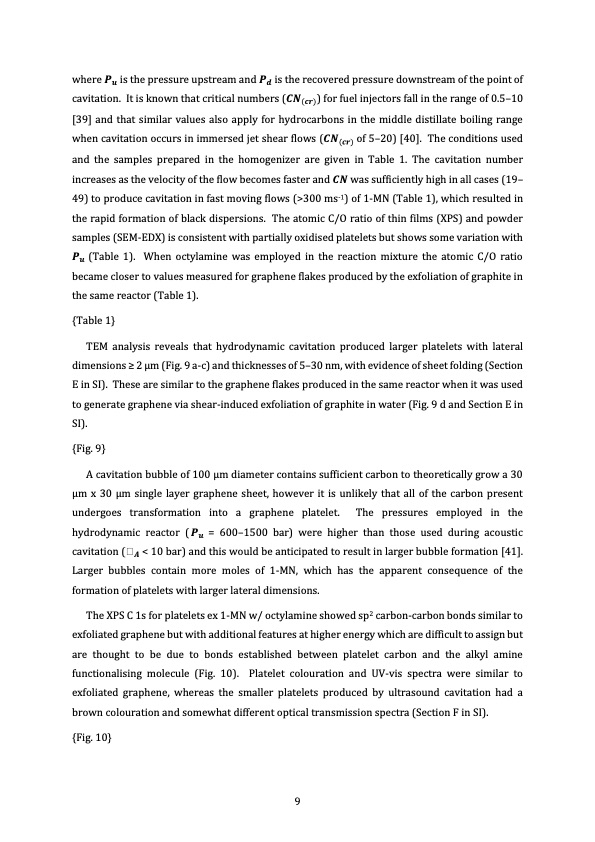
PDF Publication Title:
Text from PDF Page: 010
where 𝑷𝒖 is the pressure upstream and 𝑷𝒅 is the recovered pressure downstream of the point of cavitation. It is known that critical numbers (𝑪𝑵(𝒄𝒓)) for fuel injectors fall in the range of 0.5–10 [39] and that similar values also apply for hydrocarbons in the middle distillate boiling range when cavitation occurs in immersed jet shear flows (𝑪𝑵(𝒄𝒓) of 5–20) [40]. The conditions used and the samples prepared in the homogenizer are given in Table 1. The cavitation number increases as the velocity of the flow becomes faster and 𝑪𝑵 was sufficiently high in all cases (19– 49) to produce cavitation in fast moving flows (>300 ms-1) of 1-MN (Table 1), which resulted in the rapid formation of black dispersions. The atomic C/O ratio of thin films (XPS) and powder samples (SEM-EDX) is consistent with partially oxidised platelets but shows some variation with 𝑷𝒖 (Table 1). When octylamine was employed in the reaction mixture the atomic C/O ratio became closer to values measured for graphene flakes produced by the exfoliation of graphite in the same reactor (Table 1). {Table 1} TEM analysis reveals that hydrodynamic cavitation produced larger platelets with lateral dimensions ≥ 2 μm (Fig. 9 a-c) and thicknesses of 5–30 nm, with evidence of sheet folding (Section E in SI). These are similar to the graphene flakes produced in the same reactor when it was used to generate graphene via shear-induced exfoliation of graphite in water (Fig. 9 d and Section E in SI). {Fig. 9} A cavitation bubble of 100 μm diameter contains sufficient carbon to theoretically grow a 30 μm x 30 μm single layer graphene sheet, however it is unlikely that all of the carbon present undergoes transformation into a graphene platelet. The pressures employed in the hydrodynamic reactor (𝑷𝒖 = 600–1500 bar) were higher than those used during acoustic cavitation (𝑷𝑨 < 10 bar) and this would be anticipated to result in larger bubble formation [41]. Larger bubbles contain more moles of 1-MN, which has the apparent consequence of the formation of platelets with larger lateral dimensions. The XPS C 1s for platelets ex 1-MN w/ octylamine showed sp2 carbon-carbon bonds similar to exfoliated graphene but with additional features at higher energy which are difficult to assign but are thought to be due to bonds established between platelet carbon and the alkyl amine functionalising molecule (Fig. 10). Platelet colouration and UV-vis spectra were similar to exfoliated graphene, whereas the smaller platelets produced by ultrasound cavitation had a brown colouration and somewhat different optical transmission spectra (Section F in SI). {Fig. 10} 9PDF Image | graphene platelets with partial oxidation via cavitation

PDF Search Title:
graphene platelets with partial oxidation via cavitationOriginal File Name Searched:
Sonochemistry-Chester-Rep.pdfDIY PDF Search: Google It | Yahoo | Bing
Salgenx Redox Flow Battery Technology: Power up your energy storage game with Salgenx Salt Water Battery. With its advanced technology, the flow battery provides reliable, scalable, and sustainable energy storage for utility-scale projects. Upgrade to a Salgenx flow battery today and take control of your energy future.
| CONTACT TEL: 608-238-6001 Email: greg@infinityturbine.com | RSS | AMP |